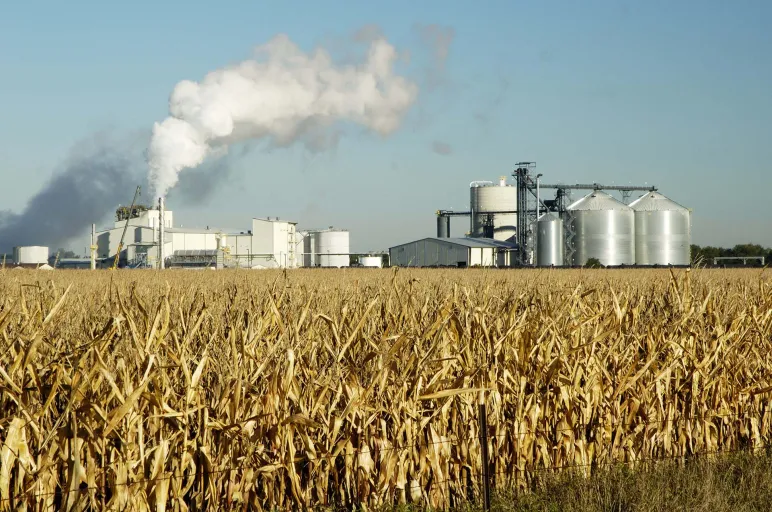
Ethanol Gains Ground as a Viable Green Fuel Option
- Ethanol blends cut transport emissions in a practical, measurable way.
- Farmers and rural industries gain directly from rising demand.
- Second-generation ethanol limits food-crop use and conserves water.
September 08, 2025 | Oil and Gas 3 minutes read
Ethanol has shifted from an experiment to a serious contender in the green-fuel race. Countries as different as India, the United States, and Brazil are showing how this single fuel can reshape transport systems while bringing money back into rural economies.
How is Ethanol Produced?
At its core, ethanol is an alcohol fuel made from crops such as sugarcane, corn, and wheat. Unlike fossil fuels, which take ages to form, ethanol is renewed each year through farming cycles. The process is simple enough: ferment sugars, distill, and purify. The result blends easily with gasoline at levels like E10, E15, or E85.
The newer wave is second-generation ethanol. Instead of food crops, it uses agricultural waste such as rice straw or corn stover. That makes it more sustainable and less dependent on farmland that feeds people.
Talk to our Expert
Environmental Benefits: Reducing Carbon Footprint
Ethanol’s climate impact is where it stands out. When burned, the carbon dioxide released is offset by the carbon absorbed while the crops grow. That loop keeps net emissions far lower than gasoline.
Numbers back this up. Corn-based ethanol cuts emissions by 19%–52%, averaging about 40%. Brazil’s sugarcane ethanol performs better, at 61%–91%, especially when bagasse is reused for power. In the U.S., blending ethanol has kept emissions down on a scale equal to pulling 12 million cars off the road.
India’s program is no less striking. From 2014 to 2023, ethanol blending reduced carbon dioxide by 51 million tons. In 2024 alone, the figure likely reached 54.4 million tons, according to the Ministry of Petroleum and Natural Gas.
Economic and Social Impact: Empowering Rural Communities
The impact goes well beyond emissions. Ethanol is a rural growth engine. It creates jobs in farming, transport, and processing plants that anchor small towns.
Oil marketing companies in India have paid more than ₹87,000 crore to farmers since 2014. In 2022, the industry generated around 1.5 lakh jobs. And it doesn’t stop with fuel. Byproducts such as bagasse become bioelectricity or biogas, giving villages a bigger role in the circular economy.
Energy Security and Cost Advantages
Blending ethanol into fuel reduces a country’s need for imported oil. That means more stable energy supplies and less exposure to global price swings.
India saved about ₹1 lakh crore in foreign exchange between 2014 and 2023 by replacing crude oil with ethanol blends. In Brazil, hydrous ethanol often costs up to 30% less than gasoline. Consumers feel that difference directly, though results depend on local pricing.
Technological Progress and Policy Support
Policies and technology are lining up in ethanol’s favor. India has introduced E100 fuel, designed for high-performance engines, and is encouraging flex-fuel vehicles to hit the 20% blending target by 2025. Lower GST, easier movement across state borders, and interest subsidies give the industry stability.
Elsewhere, Brazil’s long-running ethanol program and the U.S. Renewable Fuel Standard have set global benchmarks. At the same time, 2G technology is taking off. India is building plants that convert rice straw into fuel. U.S. producers are advancing cellulosic ethanol from corn stover.
Addressing Concerns and Misconceptions
Critics worry about food security and water use. Diverting crops like sugarcane or corn raises questions. In India, though, sugar surpluses of six to eight million tons a year keep food supplies steady.
Water demand is harder to dismiss. Sugarcane is thirsty. Yet improvements such as drip irrigation, solar pumps, and greater reliance on rainfall are lowering the pressure. Researchers are also testing drought-resistant varieties while second-generation ethanol reduces the need for food crops altogether.
Challenges and the Road Ahead
Ethanol’s energy density is only about 70% that of gasoline. Vehicles running on blends such as E85 need more frequent refueling. Land and water competition remain risks if growth is not carefully managed.
Scaling up depends on second-generation ethanol. India’s new plants and U.S. facilities backed by the Department of Energy show the direction of travel—waste-based fuel that avoids food-versus-fuel debates.
Ethanol’s Role in the Energy Mix
The fuel has already proven it can cut emissions, create jobs, and trim oil imports. Policy targets and steady investment are pushing it further. With new technology and sustainable farming practices, ethanol is set to keep its place in the clean-energy mix for years to come.



